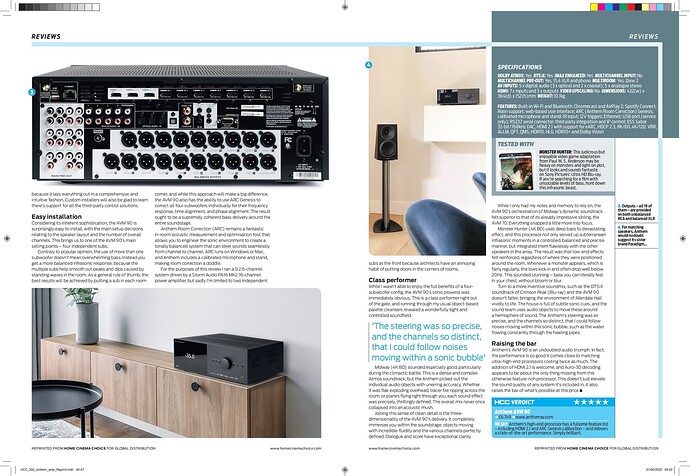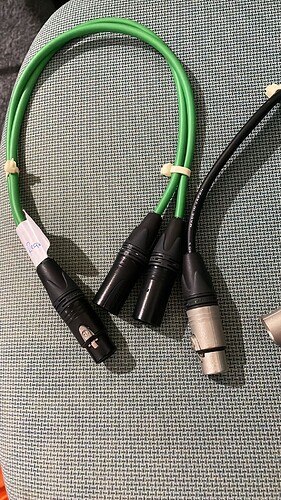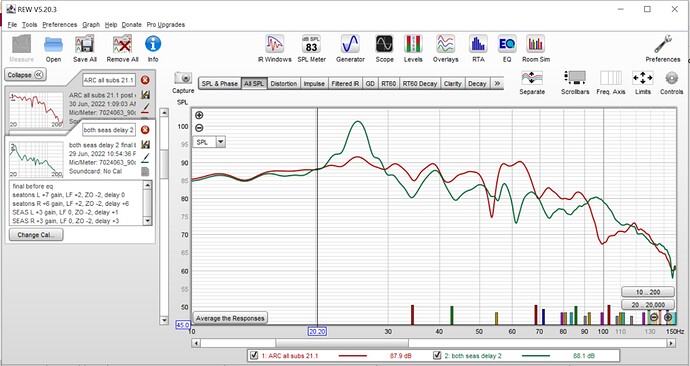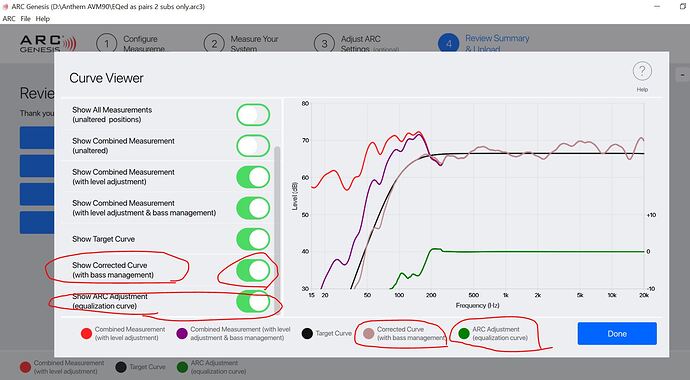@moshe, glad to see that you continue to follow Anthem product news even after you have sold your MRX 1140. Enjoying your Lygndorf MP-40 with roomPerfect?
We have a dedicated thread on Lygndorf processor that you can add on your inputs. In case you didn’t realize, it is here All Lyngdorf Related
Do I interfere in any way when I respond or actively participate in Anthem’s forum? Or did I misunderstand you?
I would love to get an answer?
And to your question I am very pleased with the Lingdorf processor.
I did one calibration and for me and in my opinion and to know everyone who was with me the result and feeling is just sonic nirvana.
![]() … Oh no no no. You have clearly misunderstood me. I am more than happy for you to continue posting in this Anthem thread, in fact I am surprised to see u continue to be active in this Anthem thread since you have just recently switched camp to Lygndorf. The only reason I have added the Lygndorf thread is to allow you to post your user experience on the MP-40 so that other members can have a different take on another brand. I certainly dont wish to see this forum to be seen as “Anthem centric” and neglect other brands. That is also why I’ve also created a new thread on the JBL Synthesis to keep things interesting to gather more awareness. I certainly did not expect my last post to have garner such a negative vibe on you… I knew you have been active in the Anthem FB group and that is where i get to know you, hence i knew you will be a great addition to contribute your knowledge and experience in using the Anthem product.
… Oh no no no. You have clearly misunderstood me. I am more than happy for you to continue posting in this Anthem thread, in fact I am surprised to see u continue to be active in this Anthem thread since you have just recently switched camp to Lygndorf. The only reason I have added the Lygndorf thread is to allow you to post your user experience on the MP-40 so that other members can have a different take on another brand. I certainly dont wish to see this forum to be seen as “Anthem centric” and neglect other brands. That is also why I’ve also created a new thread on the JBL Synthesis to keep things interesting to gather more awareness. I certainly did not expect my last post to have garner such a negative vibe on you… I knew you have been active in the Anthem FB group and that is where i get to know you, hence i knew you will be a great addition to contribute your knowledge and experience in using the Anthem product.
I hope i have clear up any misconception you have on my last post. Please feel free to post in this Anthem thread. ![]()
![]()
![]()
![]()
First of all sorry for misunderstanding you and I’m glad you clarified yourself.
I have always been a super proud owner of Anthem’s products, I have had the following models: MRX-510, MRX-710, MRX-720, MRX-1140. And every receiver I replaced surpassed its replacement and I was never disappointed with Anthem’s products and especially what the MRX-1140 I think is a work of art and the sound is mesmerizing on any scale.
I always wanted to step up and switch to the processor and amplifier separately and as a result of this strong desire I tested my AVM-70 at home for a month and did not feel sorry for it and squeezed everything out of it to be sure I was indeed doing the right thing for me.
And my conclusion was that there is not much added value to the AVM-70 compared to the MRX-1140.
There were slight differences in the level of stage width and separations but not at a level that would make me prefer the AVM-70 over the MRX-1140. As a result I left the 1140 with me and I was happy and happy with the decision I made until … I was invited to a good friend of mine who bought the Lingdorf MP-60 2.1 and from the first moment I realized that something I had never heard fell here, I was just completely shocked by the experience of listening. To Lennigdorf. I tried to undo the enthusiasm and cool it down and be loyal to my ears so I went back to visit my friend after about a week to rule out psychological effects of sorts and arrived more focused and with a more balanced and professional approach.
But nothing has changed from the previous visit ie the result and experience which I experienced even on the previous visit intensified more than the previous visit and there fell the final purchase of Lingdorf and since then I am very pleased and happy that I decided to choose LYNGDORF MP-40.
As always, thanks for sharing…Your testing of the MRX 1140 and AVM 70 really confirmed my suspicion that the performance of the two models are pretty identical even though some may claim AVM 70 have better components and because of that, it will sound significantly much better. Now we know, it was incremental and perhaps a placebo effect at work here. Of course, I bet AVM 90 is a different beast altogether because of the inclusion of the HDMI 2.1 board and better components in place to command such a high premium. I will look forward to all the AVM 90 member’s experiences here.
For what it’s worth, I will love to see your post and share your personal experiences with MP-40, like what you did here. There are a couple of members out there who will definitely like to hear your personal experiences ![]()
Nice to see misunderstandings cleared immediately in this forum!
A quick share…
REDLINE - LFE out raw from the subs
YELLOW - ARC applied. I am surprised to see the dip near 50Hz not addressed.
CYAN - fortunately the Arendals does comes with internal PEQ capability on the sub’s amp… so added some boost around there get a more even output.
The one thing I have qibbles with Anthem and ARC is the lack of micro adjustment.
The house curve adjustment in terms of room gain, boost, crossover and different frequency in terms of extensions are all nice MACRO adjustment.
We have to put all faith is the ARC algorithm calculations.
What I would like to see in future upgrade is a B4 and After measurement regime.
It is logical the need take measurements to know how to correct the raw response.
I’m just surprise the system does not do a POST measurement to VALIDATE that the ARC EQ applied produce the desired outcome. Here it’s just an assumption that it is ‘correct’… and micro adjustment would have been useful to tackle fine tuning efforts…
Am I asking too much ![]()
![]()
alright, i have had a fair amount of time with the AVM90… here it goes… more go follow along the way. Some may have been covered, but i will try and list down the pros and cons
-
First thing i noticed is, when you hook up the AVM90, and if you have 6 heights in use, you must assign Heights 1 as Front/Top Heights, followed by Middle Heights as Height 2 and finally Back for Heights 3. It goes Front-Top-Back. So i had to reconnect the XLR cables at the back! You cannot use Heights 3 as front, there is no option. Thank god not too tough. Problem solved, but if you are hooking this up the 1st time, make sure it follows the sequence.
-
After hooking the system up, the first thing the users want to know is if the speakers have been hooked up correctly or not ? Turns out the only way to verify this is to run “Quick Measure” to test. The test Noise Function doesnt work.
-
CEC command. Turning on HDMI in mutes all the HDMI out. So if you are wondering why no sound out, check HDMI IN, make sure that is off.
These were the problems i encountered, but not really problems. its just how the processor works. So take note.
The first thing i did, was to compare the RAW sound, Un’EQed version of the processor. It sounded fantastic. Beautiful midrange clarity and details. The Lyngdorf was a Distant second. Not even close when it comes to details and clarity, the AVM90 is far superior.
Once i had gotten it out of the way, i attempted my first room calibration. So i connected all 4 Preout on the subs, a pair of Seas Line Array 6x10’ woofers on each side, and a pair of Stacked 18’ seatons.
Post calibration and verification below , Lyngdorf vs Anthem
On SPLs and amplitude response
Lyngdorf
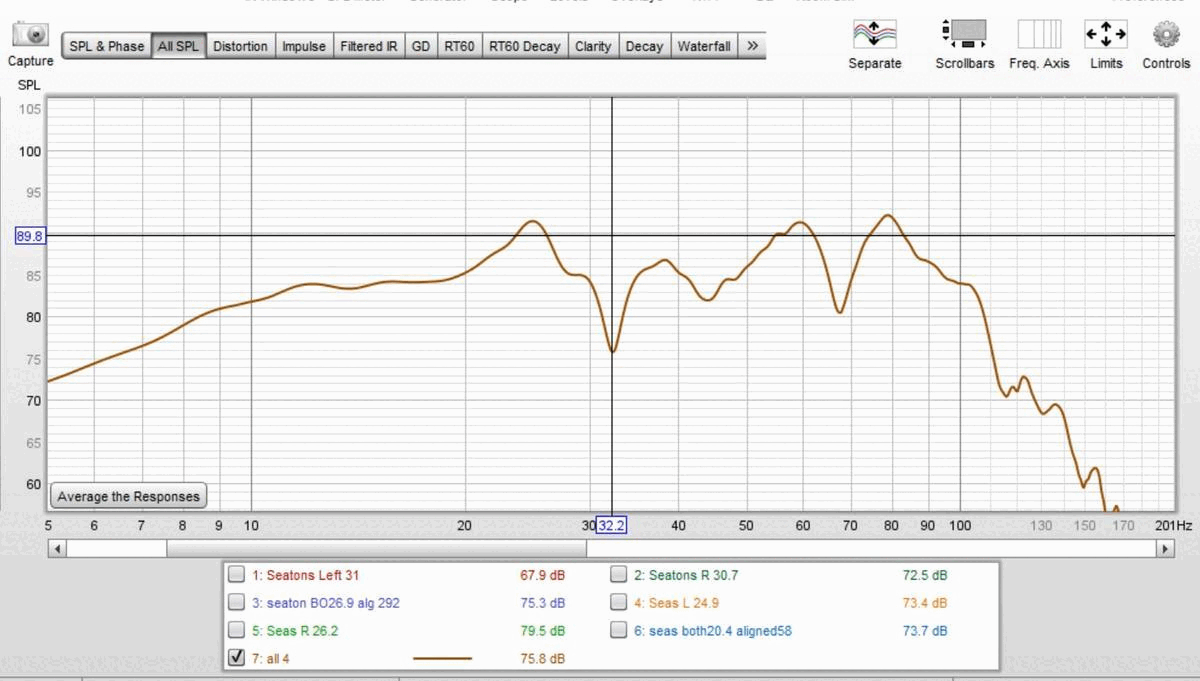
Anthem ARC

You can see above, the ARC didnt do a good Job blending all 4 subs, the Lyngdorf’s Room Perfect is far superior when it comes to blending of all 4 subs
Lets look at the decay now

You can see above, before EQ, post EQ Room perfect, vs ARC… This is pretty clear the Room Perfect room correction algorithm is far superior to ARC
the 3rd element is now Total Harmonic Distortion.
On the AVM90, you can see immediately THD is way higher compared to the Lyngdorf. its partly due to this i found.
What the ARC Does?
It focuses on correction in the amplitude domain, instead of time domain. So how it does this is it corrects for every single sub to meet a 75db target, once it meets the 75db flat target, it blends them as 1. So it corrects for all the peaks in that sub, and a max of +6db boost where necessary.One problem with this approach, lets see below :
What happens when i have a pair of seatons perfectly blended as follows
The answer is simple, there is no need for correction! It is better to blend them as 1, then only apply the correction! there is totally no need for EQ on Green Curve or Red Curve. The subs placement are already in a position of “I Help you, You help Me”. Unnecessary EQ applied and this is the problem as it takes away the headroom and introduces distortion in the transient response due to corrections on every single sub to meet the targeted 75db curve. The results is something that contradict natural sound, which imo is easily heard on the anthem AVM90. You can also easily see from the spectrogram above, the timing is not as good for subwoofer decay. While it does look good in terms of freq response of each sub, they are actually adding time/phase distortion unnecessarily to all 4 subs channel. this is why i saw a higher THD number at 90db measurements. Imagine im looking to achieve 115 DB from the subs, that is scary distortion number.
Solution ? Yes! i found one solution. That is to EQ the Subs as 1. or Dual Mono. Ill come to that later.
On auto phase, again i found the feature is good to have, but quality of blending from subs to mains is not as good, again. what it did was to shift the phase of subs to blend with the mains. but the problem with this approach is, it only shifts the phase of 2 subs, the other 2 subs do not shift. So imagine all 4 subs are blended, but only sub 1 & 3 has a phase shift. whilst it blends to mains, we are back to square 1, the 4 subs are no longer optimal before autophase as it now has a phase shift. hmmmm
On Room Perfect
It is blending all subs correctly, i can see a favourable response on amplitude, decay and THD from all 4 subs. The blending of mains to subs is also done correctly on Room Perfect. i can see a perfect summation between subs and mains and all 4 subs shift the same time. RP is also time focused when blending subs and mains+subs, it is far far superior to ARC.
Now day before yesterday i had the dilemma.
MP50- better room correction, better blending of subs, better integration of mains+subs. Poor clarity and details
AVM90 - better midrange clarity, details, upper frequencies decay. Poor blending of multisub.
The solution was to blend the subs as 1, and dont allow ARC to correct every single peak and fix some of the dips where possible. i do not want the programme to EQ before blending the sub, i want the programme to EQ the subs after blending them in. So i manually blended the subs, and only send 2 signal out, one to the seas pair, another to the seatons stacked pair. That way, there is no unnecessary EQ applied for every single sub.
The results were great!!! it Worked!!
Stay tune, more to follow… back to work now
I hear you, i have the exact same dilemma. you are right, we are at the mercy of ARC. There is no way we can have any options for PEQ or high/low shelf filters.
I have turned off room gain, deep bass boost. instead im using amplifier LF boost and amplifier power to compensate for room gain. That helps with Headroom in the digital domain. when you boost with the software, there is some lost in headroom in the digital domain. It is better to use more amplifier power, it is a better approach to preserve headroom in the digital domain. you have LFE signal and re-directed bass all going into that signal
the seatons have this option for “house curve” on its amplifier, like this below:
Thank God all speaker power amplifiers have delay options, so i can manually blend all subs as 1 before ARC Genesis
you can find post adjusted settings on the ARC file, what corrections were applied to every channel, so that is fine, it works as intended.
and i love the fact you can choose every single speaker to correct up to a given freq
in my case, i corrected up to 5khz for the centre speakers which is behind the AT screen. I kept the mains EQed to 200hz, so thats a fantastic feature i love about the ARC
If only 2 signal tat renders the 4 sub outputs redundant
Not exactly… it predicts what it thinks the result will be - NOT ACTUAL.
So it may or may not works as intended - ie actual measurement to validate that indeed the correction resulted in what it predicts. This is what I meant by “validation”.
I’m not sure how much “correction” is actually accurate…
In my case, I retained the same default 5kHz correction freq range and
ARC showed the predicted result as below:
ie the corrected curve (white pink line) is supposed to be I dunno, ±2dB max from the target curve (black line).
However below is the actual from REW.
It seems the peak and dips are still very much ±5dB;
Maybe they are using a higher level of smoothing…
It is always good to be able to show hard data to support subjective perception. In any case, actual perceive sound is much better with ARC “on” vs “off” which is the most impt thing ![]()
The truth is I have no idea how you came to these conclusions because I do not notice feel or hear everything you describe and it is quite strange that nothing from what you have described reflects the result which I have in my listening space.
But this is your opinion and personal feeling and for that I have no ability to challenge it.
What’s yours is yours.
yes, that is what i think, it doesnt do a very good job blending 4 subs. Lets look at the Post calibrated results when 4 dedicated sub outs are used vs 2 dedicated sub outs used. (2 is done via a XLR Splitter cable, connecting the seatons pair as 1 and the line array pair as 1)
splitter like this below
the one in blue below is when using 4 dedicated sub pre-outs post ARC, and the one in red, is where i blend in the pairs, and do no let ARC correct every individual sub, it corrects for the seatons pair LR as “1” and the line array pairs LR as “1”
a lot nicer on the red. Observe the red arrows (hand drawn), those are the room modes in my room. notice the red curve with 2 subs having dips and slight dips in these areas ? these are not necessarily a bad thing. it means the bass is much stronger at these frequencies in other parts of the room. Sometimes when seated at MLP, if the room modes are not attenuated, you can hear them at MLP. the measurements above were taken at MLP location.
On the contrary, look at blue, why is there a dip at 25-35hz? there is no room modes there? i wouldnt want ARC to blend it that way, i will be missing all the special effects that is heavily centred in this region from 25-35hz for most movies, that is a big blow
now if you look at before EQ of the pair , vs after ARC EQ of the pair…
it does a good job. so its working nicely as intended when blending a pair of subs. Just that when it comes to 4 dedicated subs blending, it is still not as good as Lyngdorf’s room perfect. when it comes to blending 2 subs, it does the job. So you wont see this problem, unless you have more than 2 subs.
i suspect it might be better, if we use a single sub preout and let arc correct all subs as “1”, but this approach is only if you have the means to measure and an outboard EQ for delays. For now, im happy to blend the pairs as it is, it sounded really good when done this way.
i watched alien covenant , the high frequencies decay is superb… the delay on high frequencies very long… dragged out… so it’s very nice… this dragged out decay, doesn’t mask anything … so it’s really good… the water trickling down from the cave , hitting the amulet pendant , that sound …. Tik tik tik, hitting the pendant… super good… straight away your focus is on the pendant, then u see the pendant, there is a name there…
i watched a quiet place, the dynamics were superb, the creature creating that funny noise, extends all the way to the left and clock ticking scene from the surrounds, just effortless
For those who have been to my place for the demo on the lyngdorf and if u liked that, u will thrilled when you listen to this anthem AVM90, it takes it up a few notches.
yes and another downside, is the remote! the remote is pretty lousy… very hard to press… hmmm
apart from blending of subs, blending of subs with mains and the remote, everything else is superior. Love the sound signature, fantastic!!
have you tried comparing the AVM90 vs MP-40 ? just play a few familiar scenes, with midrange clarity without any EQ. You should be able to distinguish them on the spot…
Too bad u live in Israel, otherwise i can host you…
that is not correct, it doesnt just predict, it actually shows you what is corrected.
you need to turn it on under review, “Show ARC Adjustment”. you can see ARC Adjusment made to your specific speaker and the EQ applied in Green for that particular speaker or subwoofer
in my case above as you can see, i didnt correct for main speakers above schroeder frequencies, so you can see that the green line is a straight line from 200hz onwards.
Solid works! enjoy bro!
Wow lots info.
Once u settle down need visit u with u new sofa.![]()
PS: I just share my personal analysis for AVM series but it’s AVM 70 - I love the midrange too with clarity and details.

